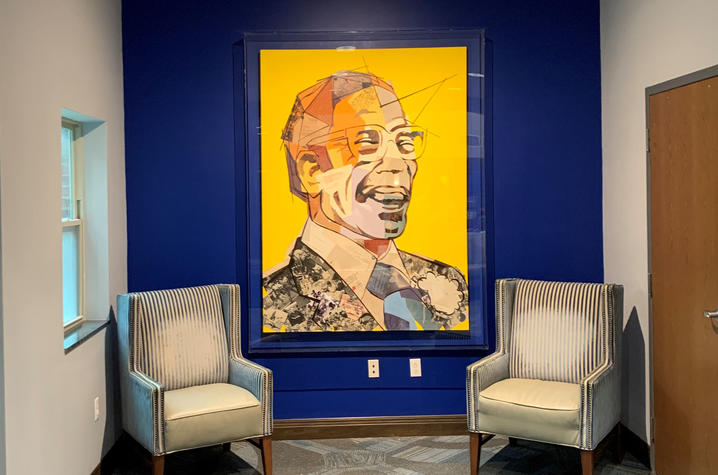Lyman T. Johnson Portrait Permanently Installed in Johnson Hall
Video produced by UK Marketing and Brand Strategy. To view captions for this video, push play and click on the CC icon in the bottom right hand corner of the screen. If using a mobile device, click on the "thought bubble" in the same area.
LEXINGTON, Ky. (Nov. 5, 2021) — In 2019, the University of Kentucky commemorated 70 years of integration on its campus. As part of that commemoration, the university commissioned a portrait of Lyman T. Johnson — the first Black student to enroll at UK in 1949 after a successful legal challenge.
This week, that portrait was installed in its intended home — the UK residence hall that bears Johnson’s name.
“Every piece of art tells a story, and the portrait of Lyman T. Johnson is an especially important one,” said UK President Eli Capilouto. “The dynamic painting reminds us of the courage and tenacity with which he challenged prejudicial systems. Part of the University of Kentucky’s history is immortalized in the portrait, which is on display in the Lyman T. Johnson residence hall where it will continue to teach and inspire us.”
Johnson’s 1949 admission to UK resulted in the university’s first racially integrated class. For Johnson, it was a grueling path.
Thirty years later, Johnson was awarded an honorary doctorate from UK.
“It’s remarkable,” Johnson wrote in his memoirs, “that so much has changed in the space of 30 years — from the time I forced my way into the university on a court order to the day the university gave me an honorary degree.”
The collage portrait, titled “I Lived Half of my Life in the Darkness, and Half in the Light,” was created by Imar Lyman Hutchins, a Washington, D.C.-based artist and grandson of Johnson.
When looking at the piece from several feet away, it appears upbeat, with a vibrant yellow background and an older Johnson's face, laughing. But upon closer inspection, the viewer will see it is compiled of pieces of hate mail received by the trailblazing civil rights pioneer, along with various photos and other historical documents from throughout his life. The threatening words and images may trigger a strong and emotional response even as they are, collectively, designed to speak to the complex racial and cultural context in which Johnson lived.
At the time of the portrait’s unveiling in 2019, Hutchins told UK that his grandfather continued to receive hate mail well into the 1990s. When asked why he chose to use those letters in the collage, Hutchins said "because it exists."
"Showing this hate mail is just an example of telling what happened. Not saying what happened doesn't change the fact that it happened. But maybe (showing) it allows people to learn from it."
“The commission honoring Lyman T. Johnson does not shy away from the realities of his life, and it is simultaneously celebratory and cautionary,” said Stuart Horodner, director of the UK Art Museum. “The bright colors and his smile give an immediate impression as a joyful portrait. Closer looking and reading of the collage elements take the viewer to a more troubling place, shedding light on the context in which Johnson lived, and the pain he endured during his socio-political realities. It is fitting that his grandson, Imar, was given the opportunity to contribute to the UK embrace of his family’s legacy.”
Hutchins said he's very proud of his work, and he thinks his grandfather would be gratified by it. But he also thinks his grandfather would stress that there is still so much more work to be done.
"What he's challenging us to do is rise above it," Hutchins said. "How could someone endure all these things and not be hard-hearted like the person who might have done it? You can say he still maintained his spirit, despite all that. That's part of the lesson for us."
The portrait was first unveiled in 2019 during the annual Lyman T. Johnson Torch of Excellence Awards ceremony at UK. After its unveiling, the piece spent two months on display at the UK Art Museum before traveling to the Muhammad Ali Center in Louisville as part of its "Inheritance" exhibition. It was then returned to the UK Art Museum in 2020, and installed in Lyman T. Johnson Hall last week.
Watch the video above to learn more about the artwork.

As the state’s flagship, land-grant institution, the University of Kentucky exists to advance the Commonwealth. We do that by preparing the next generation of leaders — placing students at the heart of everything we do — and transforming the lives of Kentuckians through education, research and creative work, service and health care. We pride ourselves on being a catalyst for breakthroughs and a force for healing, a place where ingenuity unfolds. It's all made possible by our people — visionaries, disruptors and pioneers — who make up 200 academic programs, a $476.5 million research and development enterprise and a world-class medical center, all on one campus.




